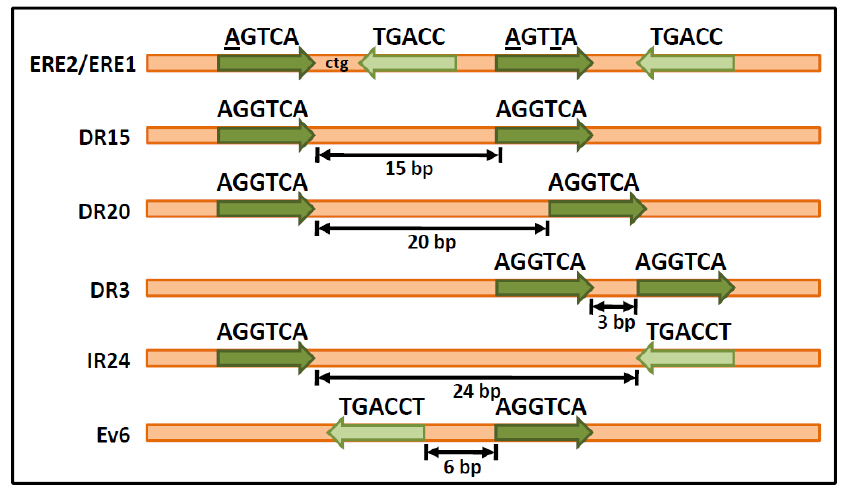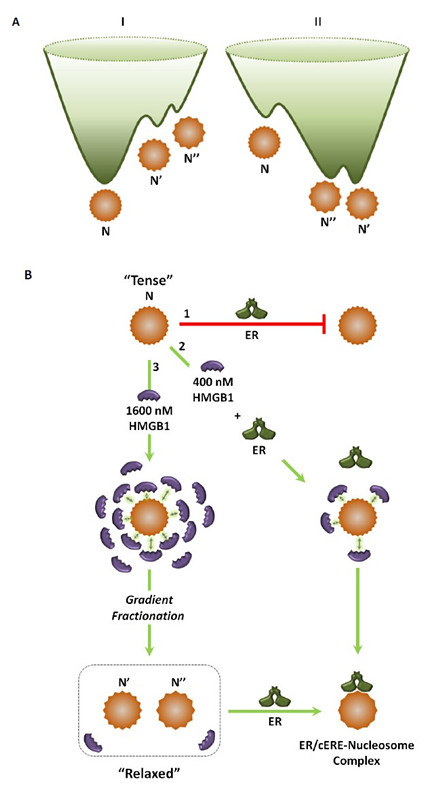|
[1]
|
Aranda A,Pascual A (2001) Nuclear hormone receptors and gene expression. Physiol Rev 81: 1269-1304.
|
|
[2]
|
Deroo BJ,Korach KS (2006) Estrogen receptors and human disease. J Clin Invest 116: 561-570. doi: 10.1172/JCI27987

|
|
[3]
|
Klinge CM (2001) Estrogen receptor interaction with estrogen response elements. Nucleic Acids Res 29: 2905-2919. doi: 10.1093/nar/29.14.2905

|
|
[4]
|
Das D,Peterson RC,Scovell WM (2004) High mobility group B proteins facilitate strong estrogen receptor binding to classical and half-site estrogen response elements and relax binding selectivity. Mol Endocrinol 18: 2616-2632. doi: 10.1210/me.2004-0125

|
|
[5]
|
El Marzouk S,Gahattamaneni R,Joshi SR,et al. (2008) The plasticity of estrogen receptor-DNA complexes: binding affinity and specificity of estrogen receptors to estrogen response element half-sites separated by variant spacers. J Steroid Biochem Mol Biol 110: 186-195. doi: 10.1016/j.jsbmb.2008.03.034

|
|
[6]
|
Gruber CJ,Gruber DM,Gruber IM,et al. (2004) Anatomy of the estrogen response element. Trends Endocrinol Metab 15: 73-78. doi: 10.1016/j.tem.2004.01.008

|
|
[7]
|
O'Lone R,Frith MC,Karlsson EK,et al. (2004) Genomic targets of nuclear estrogen receptors. Mol Endocrinol 18: 1859-1875. doi: 10.1210/me.2003-0044

|
|
[8]
|
Klinge CM,Jernigan SC,Mattingly KA,et al. (2004) Estrogen response element-dependent regulation of transcriptional activation of estrogen receptors alpha and beta by coactivators and corepressors. J Mol Endocrinol 33: 387-410. doi: 10.1677/jme.1.01541

|
|
[9]
|
Melvin VS,Edwards DP (1999) Coregulatory proteins in steroid hormone receptor action: the role of chromatin high mobility group proteins HMG-1 and -2. Steroids 64: 576-586. doi: 10.1016/S0039-128X(99)00036-7

|
|
[10]
|
Lonard DM,O'Malley B W (2007) Nuclear receptor coregulators: judges,juries,and executioners of cellular regulation. Mol Cell 27: 691-700. doi: 10.1016/j.molcel.2007.08.012

|
|
[11]
|
Lonard DM,O'Malley BW (2006) The expanding cosmos of nuclear receptor coactivators. Cell 125: 411-414. doi: 10.1016/j.cell.2006.04.021

|
|
[12]
|
Barkhem T,Haldosen LA,Gustafsson JA,et al. (2002) Transcriptional synergism on the pS2 gene promoter between a p160 coactivator and estrogen receptor-alpha depends on the coactivator subtype,the type of estrogen response element,and the promoter context. Mol Endocrinol 16: 2571-2581. doi: 10.1210/me.2002-0051

|
|
[13]
|
Thomas JO,Travers AA (2001) HMG1 and 2,and related 'architectural' DNA-binding proteins. Trends Biochem Sci 26: 167-174. doi: 10.1016/S0968-0004(01)01801-1

|
|
[14]
|
Bustin M (1999) Regulation of DNA-dependent activities by the functional motifs of the high-mobility-group chromosomal proteins. Mol Cell Biol 19: 5237-5246.
|
|
[15]
|
Bianchi ME,Agresti A (2005) HMG proteins: dynamic players in gene regulation and differentiation. Curr Opin Genet Dev 15: 496-506. doi: 10.1016/j.gde.2005.08.007

|
|
[16]
|
Ross ED,Hardwidge PR,Maher LJ,3rd (2001) HMG proteins and DNA flexibility in transcription activation. Mol Cell Biol 21: 6598-6605. doi: 10.1128/MCB.21.19.6598-6605.2001

|
|
[17]
|
Ju BG,Lunyak VV,Perissi V,et al. (2006) A topoisomerase IIbeta-mediated dsDNA break required for regulated transcription. Science 312: 1798-1802. doi: 10.1126/science.1127196

|
|
[18]
|
Das D,Scovell WM (2001) The binding interaction of HMG-1 with the TATA-binding protein/TATA complex. J Biol Chem 276: 32597-32605. doi: 10.1074/jbc.M011792200

|
|
[19]
|
Verrier CS,Roodi N,Yee CJ,et al. (1997) High-mobility group (HMG) protein HMG-1 and TATA-binding protein-associated factor TAF(II)30 affect estrogen receptor-mediated transcriptional activation. Mol Endocrinol 11: 1009-1019. doi: 10.1210/mend.11.8.9962

|
|
[20]
|
Ge H,Roeder RG (1994) The high mobility group protein HMG1 can reversibly inhibit class II gene transcription by interaction with the TATA-binding protein. J Biol Chem 269: 17136-17140.
|
|
[21]
|
Onate SA,Prendergast P,Wagner JP,et al. (1994) The DNA-bending protein HMG-1 enhances progesterone receptor binding to its target DNA sequences. Mol Cell Biol 14: 3376-3391.
|
|
[22]
|
Boonyaratanakornkit V,Melvin V,Prendergast P,et al. (1998) High-mobility group chromatin proteins 1 and 2 functionally interact with steroid hormone receptors to enhance their DNA binding in vitro and transcriptional activity in mammalian cells. Mol Cell Biol 18: 4471-4487.
|
|
[23]
|
Romine LE,Wood JR,Lamia LA,et al. (1998) The high mobility group protein 1 enhances binding of the estrogen receptor DNA binding domain to the estrogen response element. Mol Endocrinol 12: 664-674. doi: 10.1210/mend.12.5.0111

|
|
[24]
|
Zhang CC,Krieg S,Shapiro DJ (1999) HMG-1 stimulates estrogen response element binding by estrogen receptor from stably transfected HeLa cells. Mol Endocrinol 13: 632-643. doi: 10.1210/mend.13.4.0264

|
|
[25]
|
Jayaraman L,Moorthy NC,Murthy KG,et al. (1998) High mobility group protein-1 (HMG-1) is a unique activator of p53. Genes Dev 12: 462-472. doi: 10.1101/gad.12.4.462

|
|
[26]
|
Zappavigna V,Falciola L,Helmer-Citterich M,et al. (1996) HMG1 interacts with HOX proteins and enhances their DNA binding and transcriptional activation. EMBO J 15: 4981-4991.
|
|
[27]
|
Zwilling S,Konig H,Wirth T (1995) High mobility group protein 2 functionally interacts with the POU domains of octamer transcription factors. EMBO J 14: 1198-1208.
|
|
[28]
|
Butteroni C,De Felici M,Scholer HR,et al. (2000) Phage display screening reveals an association between germline-specific transcription factor Oct-4 and multiple cellular proteins. J Mol Biol 304: 529-540. doi: 10.1006/jmbi.2000.4238

|
|
[29]
|
Brickman JM,Adam M,Ptashne M (1999) Interactions between an HMG-1 protein and members of the Rel family. Proc Natl Acad Sci U S A 96: 10679-10683. doi: 10.1073/pnas.96.19.10679

|
|
[30]
|
Bonaldi T,Langst G,Strohner R,et al. (2002) The DNA chaperone HMGB1 facilitates ACF/CHRAC-dependent nucleosome sliding. EMBO J 21: 6865-6873. doi: 10.1093/emboj/cdf692

|
|
[31]
|
Formosa T (2012) The role of FACT in making and breaking nucleosomes. Biochim Biophys Acta 1819: 247-255. doi: 10.1016/j.bbagrm.2011.07.009

|
|
[32]
|
Metivier R,Penot G,Hubner MR,et al. (2003) Estrogen receptor-alpha directs ordered,cyclical,and combinatorial recruitment of cofactors on a natural target promoter. Cell 115: 751-763. doi: 10.1016/S0092-8674(03)00934-6

|
|
[33]
|
Carroll JS,Brown M (2006) Estrogen receptor target gene: an evolving concept. Mol Endocrinol 20: 1707-1714. doi: 10.1210/me.2005-0334

|
|
[34]
|
Carroll JS,Meyer CA,Song J,et al. (2006) Genome-wide analysis of estrogen receptor binding sites. Nat Genet 38: 1289-1297. doi: 10.1038/ng1901

|
|
[35]
|
Fan HY,He X,Kingston RE,et al. (2003) Distinct strategies to make nucleosomal DNA accessible. Mol Cell 11: 1311-1322. doi: 10.1016/S1097-2765(03)00192-8

|
|
[36]
|
Kinyamu HK,Archer TK (2004) Modifying chromatin to permit steroid hormone receptor-dependent transcription. Biochim Biophys Acta 1677: 30-45. doi: 10.1016/j.bbaexp.2003.09.015

|
|
[37]
|
Becker PB,Horz W (2002) ATP-dependent nucleosome remodeling. Annu Rev Biochem 71: 247-273. doi: 10.1146/annurev.biochem.71.110601.135400

|
|
[38]
|
Joshi SR,Ghattamaneni RB,Scovell WM (2011) Expanding the paradigm for estrogen receptor binding and transcriptional activation. Mol Endocrinol 25: 980-994. doi: 10.1210/me.2010-0302

|
|
[39]
|
Li Q,Bjork U,Wrange O (1999) Assays for interaction of transcription factor with nucleosome. Methods Enzymol 304: 313-332. doi: 10.1016/S0076-6879(99)04019-7

|
|
[40]
|
Joshi SR,Sarpong YC,Peterson RC,et al. (2012) Nucleosome dynamics: HMGB1 relaxes canonical nucleosome structure to facilitate estrogen receptor binding. Nucleic Acids Res 40: 10161-10171. doi: 10.1093/nar/gks815

|
|
[41]
|
Ner SS,Travers AA,Churchill ME (1994) Harnessing the writhe: a role for DNA chaperones in nucleoprotein-complex formation. Trends Biochem Sci 19: 185-187. doi: 10.1016/0968-0004(94)90017-5

|
|
[42]
|
Wolffe AP,Hayes JJ (1999) Chromatin disruption and modification. Nucleic Acids Res 27: 711-720. doi: 10.1093/nar/27.3.711

|
|
[43]
|
Melvin VS,Harrell C,Adelman JS,et al. (2004) The role of the C-terminal extension (CTE) of the estrogen receptor alpha and beta DNA binding domain in DNA binding and interaction with HMGB. J Biol Chem 279: 14763-14771. doi: 10.1074/jbc.M313335200

|
|
[44]
|
Ediger TR,Park SE,Katzenellenbogen BS (2002) Estrogen receptor inducibility of the human Na+/H+ exchanger regulatory factor/ezrin-radixin-moesin binding protein 50 (NHE-RF/EBP50) gene involving multiple half-estrogen response elements. Mol Endocrinol 16: 1828-1839. doi: 10.1210/me.2001-0290

|
|
[45]
|
Vasudevan N,Ogawa S,Pfaff D (2002) Estrogen and thyroid hormone receptor interactions: physiological flexibility by molecular specificity. Physiol Rev 82: 923-944. doi: 10.1152/physrev.00014.2002

|
|
[46]
|
Zhu YS,Yen PM,Chin WW,et al. (1996) Estrogen and thyroid hormone interaction on regulation of gene expression. Proc Natl Acad Sci U S A 93: 12587-12592. doi: 10.1073/pnas.93.22.12587

|
|
[47]
|
Kingston RE,Narlikar GJ (1999) ATP-dependent remodeling and acetylation as regulators of chromatin fluidity. Genes Dev 13: 2339-2352. doi: 10.1101/gad.13.18.2339

|
|
[48]
|
Vignali M,Hassan AH,Neely KE,et al. (2000) ATP-dependent chromatin-remodeling complexes. Mol Cell Biol 20: 1899-1910. doi: 10.1128/MCB.20.6.1899-1910.2000

|
|
[49]
|
Narlikar GJ,Sundaramoorthy R,Owen-Hughes T (2013) Mechanisms and functions of ATP-dependent chromatin-remodeling enzymes. Cell 154: 490-503. doi: 10.1016/j.cell.2013.07.011

|
|
[50]
|
Xue Y,Wong J,Moreno GT,et al. (1998) NURD,a novel complex with both ATP-dependent chromatin-remodeling and histone deacetylase activities. Mol Cell 2: 851-861. doi: 10.1016/S1097-2765(00)80299-3

|
|
[51]
|
Schnitzler G,Sif S,Kingston RE (1998) Human SWI/SNF interconverts a nucleosome between its base state and a stable remodeled state. Cell 94: 17-27. doi: 10.1016/S0092-8674(00)81217-9

|
|
[52]
|
Lorch Y,Cairns BR,Zhang M,et al. (1998) Activated RSC-nucleosome complex and persistently altered form of the nucleosome. Cell 94: 29-34. doi: 10.1016/S0092-8674(00)81218-0

|
|
[53]
|
Narlikar GJ,Phelan ML,Kingston RE (2001) Generation and interconversion of multiple distinct nucleosomal states as a mechanism for catalyzing chromatin fluidity. Mol Cell 8: 1219-1230. doi: 10.1016/S1097-2765(01)00412-9

|
|
[54]
|
Cote J,Peterson CL,Workman JL (1998) Perturbation of nucleosome core structure by the SWI/SNF complex persists after its detachment,enhancing subsequent transcription factor binding. Proc Natl Acad Sci U S A 95: 4947-4952. doi: 10.1073/pnas.95.9.4947

|
|
[55]
|
Bazett-Jones DP,Cote J,Landel CC,et al. (1999) The SWI/SNF complex creates loop domains in DNA and polynucleosome arrays and can disrupt DNA-histone contacts within these domains. Mol Cell Biol 19: 1470-1478.
|
|
[56]
|
Nardulli AM,Grobner C,Cotter D (1995) Estrogen receptor-induced DNA bending: orientation of the bend and replacement of an estrogen response element with an intrinsic DNA bending sequence. Mol Endocrinol 9: 1064-1076.
|
|
[57]
|
Nardulli AM,Greene GL,Shapiro DJ (1993) Human estrogen receptor bound to an estrogen response element bends DNA. Mol Endocrinol 7: 331-340.
|
|
[58]
|
Cary PD,Moss T,Bradbury EM (1978) High-resolution proton-magnetic-resonance studies of chromatin core particles. Eur J Biochem 89: 475-482. doi: 10.1111/j.1432-1033.1978.tb12551.x

|
|
[59]
|
Perutz MF (1978) Hemoglobin structure and respiratory transport. Sci Am 239: 92-125.
|
|
[60]
|
Melvin VS,Roemer SC,Churchill ME,et al. (2002) The C-terminal extension (CTE) of the nuclear hormone receptor DNA binding domain determines interactions and functional response to the HMGB-1/-2 co-regulatory proteins. J Biol Chem 277: 25115-25124. doi: 10.1074/jbc.M110400200

|
|
[61]
|
Li Q,Wrange O (1993) Translational positioning of a nucleosomal glucocorticoid response element modulates glucocorticoid receptor affinity. Genes Dev 7: 2471-2482. doi: 10.1101/gad.7.12a.2471

|
|
[62]
|
Fletcher TM,Xiao N,Mautino G,et al. (2002) ATP-dependent mobilization of the glucocorticoid receptor during chromatin remodeling. Mol Cell Biol 22: 3255-3263. doi: 10.1128/MCB.22.10.3255-3263.2002

|
|
[63]
|
Walker P,Germond JE,Brown-Luedi M,et al. (1984) Sequence homologies in the region preceding the transcription initiation site of the liver estrogen-responsive vitellogenin and apo-VLDLII genes. Nucleic Acids Res 12: 8611-8626. doi: 10.1093/nar/12.22.8611

|
|
[64]
|
Reese JC,Katzenellenbogen BS (1991) Differential DNA-binding abilities of estrogen receptor occupied with two classes of antiestrogens: studies using human estrogen receptor overexpressed in mammalian cells. Nucleic Acids Res 19: 6595-6602. doi: 10.1093/nar/19.23.6595

|















 DownLoad:
DownLoad: